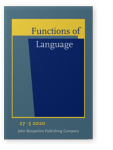Vol. 27:3 (2020) ► pp.280–306
Give as a light verb
Light Verb Constructions (LVCs) have received widespread attention. Research on these constructions, however, has for the most part focused exclusively on their syntactic and lexical-semantic properties. Additionally, studies devoted to specific LVCs tend to neglect the phrasal-semantic and pragmatic variation brought about by the combination of a light verb with different nominal complements. This paper tries to fill those gaps by means of a quantitative and qualitative corpus-based study of Light give Constructions (LgiveCs). The quantitative analysis investigates frequencies of LgiveCs in British English and compares them across spoken and written (fiction) discourse, which reveals a high frequency of this construction in speech, especially in combinations of give with a ring, a kiss and an answer. When these combinations are excluded, LgiveCs are significantly more frequent in writing. In a complementary qualitative approach, we highlight the structural and discursive features of the construction and attempt to explore the factors that motivate the frequent use of the LgiveC in British English.
Article outline
- 1.Introduction
- 2. give as a light verb
- 3.Research goals and methodology
- 4.Light give in spoken and written (fiction) discourse: Frequency and distribution
- 5.The form and meaning of the LgiveC
- 5.1Semantic features
- 5.2Patterns of modification and transitivity
- 5.3Grammatical choices within the verb phrase
- 5.4Summary
- 6.The LgiveC in context
- 6.1Discourse-organisation and textual meanings
- 6.2Intersubjective and interactional meanings
- 6.3Summary
- 7.Conclusion
- Acknowledgements
- Notes
-
References
